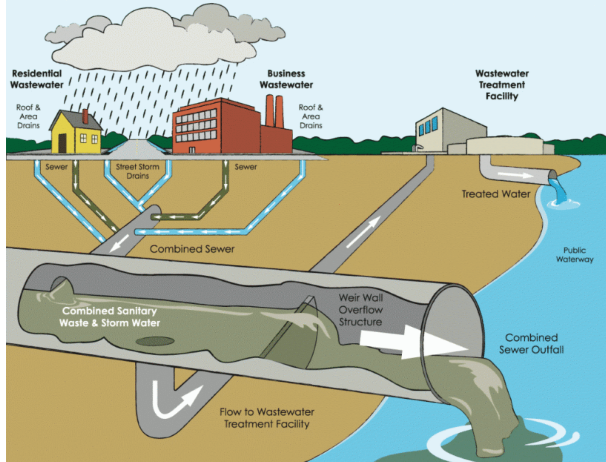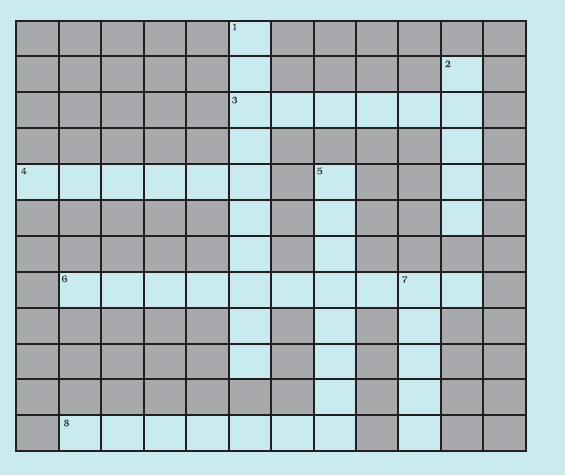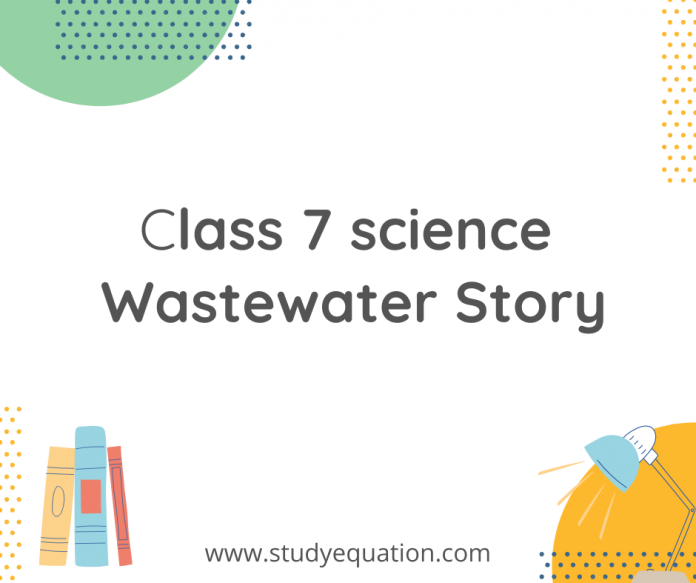Ncert solutions for class 7 science Wastewater Story. This chapter is based on water pollution and the pollutants involved. It also lays emphasis on the harmfulness of contaminated water. The working of the Waste Water treatment Plant is also elaborated upon in this summary. Wastewater story class 7 extra questions with answers, wastewater story class 7 notes have been provided.
Read more: Ncert solutions for class 7 science Transportation in Animals and Plants
Table of Contents
Summary Ncert solutions for class 7 science Wastewater Story
Water pollution
When water in the oceans, waters, rivers , streams, wetlands and beneath the earth get polluted, it is called water pollution. Water contamination leads to a difference in its physical , biological and chemical characteristics, rendering it unhealthy for consumption or other uses. These pollutants are the contaminants that cause water pollution. Water pollution may have significant effects, such as diseases, on the ecology of an area, aquatic life, etc.

Major water pollutants
- Sewage: Not only does it harm the water body’s marine ecosystem, but it also contributes to serious diseases such as cholera, diarrhoea and typhoid.
- Industrial waste: Harmful chemicals such as lead and mercury are often dumped by industries into the water bodies directly which contaminate their water.
- Agricultural waste: Fertilizers, pesticides, insecticides and farm wastes are often washed off by the rain to the water bodies and contaminate the water.
- Oil spills: Oil spills often occur due to accidents and leakages of oil in the sea which leads to loss of aquatic life.
- Thermal waste: Thermal industries often spill warm water in the water bodies which decreases its oxygen content. It also leads to a rise in temperature of water which is not suitable for aquatic animals.
- Suspended solids: They come from soil erosion, untreated sewage and mining. These suspended pollutants block the sunlight from reaching the aquatic plants and animals.

Wastewater Treatment Plant (WWTP)
Wastewater includes biological, physical and chemical matter and hence involves biological, physical and chemical processes of removal of the contaminants.
The physical and biological process of treatment of water:
1. Separation of Large Objects from Sewage Water: The wastewater is first passed through bar screens which remove big objects from the water like plastic bottles, napkins, rags, cans and sticks.
2. Separation of Sand and Dirt: The wastewater is then sent to a grit and sand removal tank. This allows the sand, dirt and pebbles to settle down.
3. Removal of Solids: The water cycles in a tank called Clarifier which is sloped in the centre. This lets the solids like faeces to settle at the bottom known as sludge which is separated from the water with the help of a Scrapper. Substances like oil and grease are removed with the help of a Skimmer as they float above the water. In this step clarified water is obtained. The sludge so obtained is passed into a tank where anaerobic bacteria can decompose it and produce biogas. The biogas is then used as a fuel.
4. Suspended Sludge Removal: The clarified water also needs to be cleaned further. Hence, it is moved to an aerator that pumps air into it. This allows aerobic bacteria to grow in this water. The aerobic bacteria consume organic waste, soaps, food waste and other elements that remain in the clarified water. This water is allowed to settle for several hours and then these waste materials settle down in the tank. This is called Activated Sludge. The water is removed from the top of this sludge with the help of machines or sand drying beds. The sludge is then dried and can be used as manure.
This treated water contains fewer amounts of impurities and suspended matter. This water is safe to dump into a water body or under the ground. Hence, it is then discharged into a sea, river or underground. Nature further cleans it up.
Chemical Treatment of Wastewater:
Sometimes harmful chemicals can be present in the water even after treating them physically and biologically. These chemicals are therefore removed by using disinfectants such as chlorine and Ozone. Often chlorine gas or ozone gas is introduced in this water which purifies it chemically.
Alternative Arrangement for Sewage Disposal
As an alternative for sewage disposal on-site sewage is being used nowadays, for example, septic tanks, compost pit toilets and chemical toilets. The onsite sewage treatments use natural procedures to treat and dispose of the wastewater or sewage. This system is suitable in places where there is no central wastewater collection system.
- Septic Tanks – A septic tank is often installed under the ground in houses or buildings such as hospitals. It allows decomposition of sewage from home through the action of anaerobic bacteria.
- Chemical Toilets – A chemical toilet has a separate compartment that treats human waste with chemicals and decreases their odour.
- Composting Toilets – A composting toilet treats human waste with biological processes. The aerobic bacteria are present in a storage tank that act upon the waste and turn it into compost.
- Many organizations have also installed on-site hygienic waste disposal technology in which the human excreta directly flows into a biogas plant and is then used as an energy resource.
Conclusion Ncert solutions for class 7 science Wastewater Story
Ncert solutions for class 7 science Wastewater Story – Thus we learn abut the various ways in which we can prevent waste water from contaminating useful water. This will be beneficial not only for us but also for the ecosystem as a whole. Wastewater story class 7 notes and wastewater story class 7 extra questions with answers have been provided.
Questions and answers Ncert solutions for class 7 science Wastewater Story
1. Fill in the blanks:
(a) Cleaning of water is a process of removing ____________.
(b) Wastewater released by houses is called ____________.
(c) Dried ____________ is used as manure.
(d) Drains get blocked by ____________ and ____________.
Solution:
(a) Cleaning of water is a process of removing pollutants.
(b) Wastewater released by houses is called sewage.
(c) Dried sludge is used as manure.
(d) Drains get blocked by cooking oil and fats.
2. What is sewage? Explain why it is harmful to discharge untreated sewage into rivers or seas.
Wastewater released by houses is called sewage. Untreated sewage should not be discharged untreated into the sea because sewage consists of pollutants and harmful microorganisms which will contaminate water causing disease in people using contaminated water.
3. Why should oils and fats be not released in the drain? Explain.
Solution:
Oils and fats should not be released in the drain because drains get blocked by cooking oil and fats.
Short answers
4. Describe the steps involved in getting clarified water from wastewater.
Solution:
Use an aerator from an aquarium to bubble air through the sample in the glass jar. Allow several hours for aeration; leave the aerator attached overnight. If you do not have an aerator, use a mechanical stirrer or a mixer. This reduces the foul smell of wastewater.
Then, the water is filtered through the layers of sand, fine gravel, and medium gravel. Filtration makes the wastewater clean from various types of pollutants. The water is filtered continuously until it becomes clear.
Water is disinfected by using a chlorine tablet.
5. What is sludge? Explain how it is treated.
Solution:
Solids like faeces settle at the bottom while treating sewage, and this material is called as sludge. Sludge can be treated as follows
Sludge is removed using a skimmer and then transferred to a tank where it is decomposed by anaerobic bacteria to produce biogas.
Short answers
6. Untreated human excreta is a health hazard. Explain
Solution:
Untreated human excreta is a health hazard because it consists of various disease-causing microorganisms and pollutants that will contaminate the soil and water resource from where people draw water for drinking and domestic purposes. When people use water contaminated with human excreta, they get diseases like Cholera, Typhoid, Dysentry and Hepatitis.
7. Name two chemicals used to disinfect water
Solution:
Chlorine and Ozone are used to disinfect water.
8. Explain the function of bar screens in a wastewater treatment plant.
Solution:
Bar screen removes large objects like rags, sticks, cans, plastic packets and napkins.
9. Explain the relationship between sanitation and disease.
Solution:
Sanitisation and disease are interrelated as lack of sanitisation lead to illness and good sanitisation practices prevent the diseases.
Short answers
10. Outline your role as an active citizen in relation to sanitation.
Solution:
Every citizen has a role to play in maintaining proper sanitisation. Following are the things we should follow to play an active role.
- Ensure that our surroundings are kept clean.
- The sewage system in the house should be properly managed
- Report to the concerned authoritive immediately in case of leakages in sewage pipes.
11. Here is a crossword puzzle: Good luck!

Across
3. Liquid waste products
4. Solid waste extracted in sewage treatment
6. A word related to hygiene
8. Waste matter discharged from human body
Down
1. Used water
2. A pipe carrying sewage
5. Micro-organisms which causes cholera
7. A chemical to disinfect water
Solution:
Across
3. Sewage
4. Sludge
6. Sanitation
8. Excreta
Down
1. Wastewater
2. Sewer
5. Bacteria
7. Ozone
12. Study the following statements about ozone:
(a) It is essential for breathing of living organisms.
(b) It is used to disinfect water.
(c) It absorbs ultraviolet rays.
(d) Its proportion in air is about 3%. Which of these statements are correct?
(i) (a), (b) and (c)
(ii) (b) and (c)
(iii) (a) and (d)
(iv) All four
Solution:
The answer is (ii) (b) and (c)





